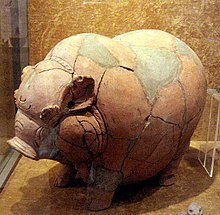"Of all the buildings, none lack pillars, bearing fine carvings and coloured" [Within the wall compounds] "there were elegant pavilions roofed with aren fibre, like the scene in a painting... The petals of the katangga were sprinkled over the roofs for they had fallen in the wind. The roofs were like maidens with flowers arranged in their hair, delighting those who saw them".The main event of the administrative calendar took place on the first day of the month of Caitra (March–April) when representatives from all territories paying tax or tribute to Majapahit came to the capital to pay court. Majapahit's territories were roughly divided into three types: the palace and its vicinity; the areas of east Java and Bali which were directly administered by officials appointed by the king; and the outer dependencies which enjoyed substantial internal autonomy.
— Description of the Majapahit capital from the Old Javanese epic poem Nagarakertagama.
The capital (Trowulan) was grand and known for its great annual festivities. Buddhism, Shaivism, and Vaishnavism were all practiced, and the king was regarded as the incarnation of the three. The Nagarakertagama does not mention Islam, but there were certainly Muslim courtiers by this time.
Although brick had been used in the candi of Indonesia's classical age, it was Majapahit architects of the 14th and 15th centuries who mastered it. Making use of a vine sap and palm sugar mortar, their temples had a strong geometric quality. The Majapahit Terracotta art also flourished in this period. Significant numbers of terracotta artifacts were discovered in Trowulan. The artifacts ranges from human and animal figurines, water containers, piggy banks, architectural ornaments, to pipes and roof tiles.
"....the King [of Java] has subject to himself seven crowned kings. [Yet] his island is populous, and is the second best of all island that exist.... The king of this island has a palace which is truly marvelous. For it is very great, the stairs and palace interior were coated with gold and silver, even the roof were gilded with gold. Now the Great Khan of China many a time engaged in war with this king; but this king always vanquished and get the better of him."The first European record about Majapahit came from the travel log of the Italian Mattiussi, a Franciscan monk. In his book: "Travels of Friar Odoric of Pordenone", he visited several places in today's Indonesia: Sumatra, Java, and Banjarmasin in Borneo, between 1318-1330. He was sent by the Pope to launch a misson into the Asian interiors. In 1318 he departed from Padua, crossed the Black Sea into Persia, all the way across Calcutta, Madras, and Srilanka. He then headed to Nicobar island all the way to Sumatra, before visiting Java and Banjarmasin. He returned to Italy by land through Vietnam, China, all the way through the silkroad to Europe in 1330.
— Description of Majapahit by Mattiussi (Friar Odoric of Pordenone).
In his book he mentioned that he visited Java without explaining the exact place he had visited. He said that king of Java ruled over seven other kings (vassals). He also mentioned that in this island was found a lot of clove, cubeb, nutmeg and many other spices. He mentioned that the King of Java had an impressive, grand, and luxurious palace. The stairs and palace interior were coated with gold and silver, and even the roof were gilded. He also recorded that the kings of the Mongol has repeatedly tried to attack Java, but always ended up in failure and managed to be sent back to the mainland. The Javanese kingdom mentioned in this record is Majapahit, and the time of his visit is between 1318-1330 during the reign of Jayanegara.
Economy

Majapahit Terracotta Piggy Bank, 14-15 century AD Trowulan, East Java. (Collection of National Museum of Indonesia, Jakarta)
Some idea of scale of the internal economy can be gathered from scattered data in inscriptions. The Canggu inscriptions dated 1358 mentions 78 ferry crossings in the country (mandala Java). Majapahit inscriptions mention a large number of occupational specialities, ranging from gold and silver smiths to drink vendors and butchers. Although many of these occupations had existed in earlier times, the proportion of the population earning an income from non-agrarian pursuits seems to have become even greater during the Majapahit era.
The great prosperity of Majapahit was probably due to two factors. Firstly, the northeast lowlands of Java were suitable for rice cultivation, and during Majapahit's prime numerous irrigation projects were undertaken, some with government assistance. Secondly, Majapahit's ports on the north coast were probably significant stations along the route to obtain the spices of Maluku, and as the spices passed through Java they would have provided an important source of income for Majapahit.
The Nagarakertagama states that the fame ruler of Wilwatikta (a synonym for Majapahit) attracted foreign merchants from far and wide, including Indians, Khmers, Siamese, and Chinese among others. A special tax was levied against some foreigners, possibly those who had taken up semi-permanent residence in Java and conducted some type of enterprise other than foreign trade.

0 comments:
Post a Comment